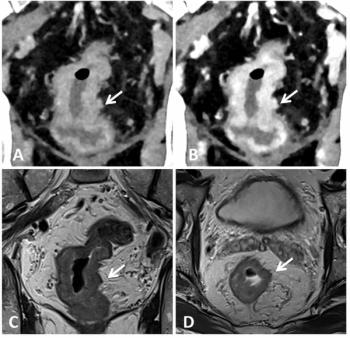
Transesophageal MRI shows early plaque reduction
Faster MR gradients, improved surface coil designs, and the use of an intraesophageal antenna functioning as an additional receiver have enabled researchers to document atherosclerotic plaque regression within six months of statin therapy. Previous MR technology could verify the same response only after a year of drug treatment.
Faster MR gradients, improved surface coil designs, and the use of an intraesophageal antenna functioning as an additional receiver have enabled researchers to document atherosclerotic plaque regression within six months of statin therapy. Previous MR technology could verify the same response only after a year of drug treatment.
MR monitoring could lead to better drug targeting by identifying patients whose cholesterol level has dropped but who may not have a corresponding plaque reduction. These patients may need a higher statin dosage than patients who have a prompt therapeutic response, said Dr. David Bluemke, clinical director of MR at Johns Hopkins University.
"It's one thing to take a statin and have your cholesterol decline. But atherosclerosis takes years to build in the arteries. Until recently, we didn't know that this effect is potentially reversible," Bluemke said.
In a recent study, Dr. Joao A.C. Lima, an associate professor of medicine and radiology at Johns Hopkins, and colleagues examined the effects of simvastatin (Zocor) therapy in 27 patients (Circulation 2004;110[16]: 2336-2341). The researchers measured lipid levels with traditional laboratory tests and imaged patients using transesophageal MR at 1.5T. After six months of statin therapy, the average atherosclerotic plaque volumes decreased from 3.3 cm3 at baseline to 2.9 cm3. Additionally, luminal volumes measured from six cross-sections opened from 12 cm3 to 12.2 cm3. A corresponding reduction in LDL cholesterol levels was also recorded.
Since lipid levels alone do not necessarily indicate who is benefiting most from drug therapy, MR imaging should be considered a complementary technique to their measurement, Lima said.
Carotid ultrasound and intravascular coronary ultrasound are the methods primarily used to monitor atherosclerosis buildup. Clinical trials using both techniques documented plaque volume changes only after a year of therapy. In addition, ultrasound does not depict plaques as accurately as MR does, Lima said.
Newer generation CT scanners may be able to provide similar results, but a CT scan would require IV contrast and expose the patient to radiation, which are drawbacks for long-term plaque reduction monitoring.
Newsletter
Stay at the forefront of radiology with the Diagnostic Imaging newsletter, delivering the latest news, clinical insights, and imaging advancements for today’s radiologists.



























